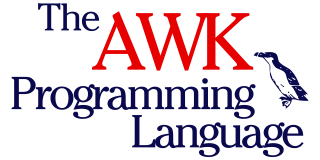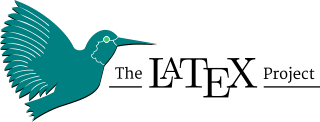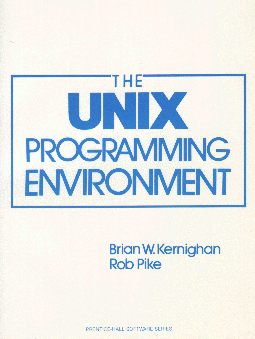Related Research Articles

AWK is a domain-specific language designed for text processing and typically used as a data extraction and reporting tool. Like sed and grep, it is a filter, and is a standard feature of most Unix-like operating systems.

LaTeX is a software system for typesetting documents. LaTeX markup describes the content and layout of the document, as opposed to the formatted text found in WYSIWYG word processors like Microsoft Word, LibreOffice Writer and Apple Pages. The writer uses markup tagging conventions to define the general structure of a document, to stylise text throughout a document, and to add citations and cross-references. A TeX distribution such as TeX Live or MiKTeX is used to produce an output file suitable for printing or digital distribution.
TeX, stylized within the system as TeX, is a typesetting system which was designed and written by computer scientist and Stanford University professor Donald Knuth and first released in 1978. TeX is a popular means of typesetting complex mathematical formulae; it has been noted as one of the most sophisticated digital typographical systems.
troff, short for "typesetter roff", is the major component of a document processing system developed by Bell Labs for the Unix operating system. troff and the related nroff were both developed from the original roff.

GNU TeXmacs is a scientific word processor and typesetting component of the GNU Project. It originated as a variant of GNU Emacs with TeX functionalities, though it shares no code with those programs, while using TeX fonts. It is written and maintained by Joris van der Hoeven and a group of developers. The program produces structured documents with a WYSIWYG user interface. New document styles can be created by the user. The editor provides high-quality typesetting algorithms and TeX and other fonts for publishing professional looking documents.

Typesetting is the composition of text for publication, display, or distribution by means of arranging physical type in mechanical systems or glyphs in digital systems representing characters. Stored types are retrieved and ordered according to a language's orthography for visual display. Typesetting requires one or more fonts. One significant effect of typesetting was that authorship of works could be spotted more easily, making it difficult for copiers who have not gained permission.
nroff is a text-formatting program on Unix and Unix-like operating systems. It produces output suitable for simple fixed-width printers and terminal windows. It is an integral part of the Unix help system, being used to format man pages for display.
The C preprocessor is the macro preprocessor for several computer programming languages, such as C, Objective-C, C++, and a variety of Fortran languages. The preprocessor provides inclusion of header files, macro expansions, conditional compilation, and line control.
MetaPost refers to both a programming language and the interpreter of the MetaPost programming language. Both are derived from Donald Knuth's Metafont language and interpreter. MetaPost produces vector graphic diagrams from a geometric/algebraic description. The language shares Metafont's declarative syntax for manipulating lines, curves, points and geometric transformations. However,
Ratfor is a programming language implemented as a preprocessor for Fortran 66. It provides modern control structures, unavailable in Fortran 66, to replace GOTOs and statement numbers.

Texinfo is a typesetting syntax used for generating documentation in both on-line and printed form with a single source file. It is implemented by a computer program released as free software of the same name, created and made available by the GNU Project from the Free Software Foundation.
m4 is a general-purpose macro processor included in most Unix-like operating systems, and is a component of the POSIX standard.
Part of the troff suite of Unix document layout tools, eqn is a preprocessor that formats equations for printing. A similar program, neqn, accepted the same input as eqn, but produced output tuned to look better in nroff. The eqn program was created in 1974 by Brian Kernighan and Lorinda Cherry. It was implemented using yacc compiler-compiler.
Part of the troff suite of Unix document layout tools, tbl is a preprocessor that formats tables in preparation for processing with troff/nroff.

The Unix Programming Environment, first published in 1984 by Prentice Hall, is a book written by Brian W. Kernighan and Rob Pike, both of Bell Labs and considered an important and early document of the Unix operating system.

Asymptote is a descriptive vector graphics language – developed by Andy Hammerlindl, John C. Bowman, and Tom Prince – which provides a natural coordinate-based framework for technical drawing. Asymptote runs on all major platforms. It is free software, available under the terms of the GNU Lesser General Public License (LGPL).

groff is a typesetting system that creates formatted output when given plain text mixed with formatting commands. It is the GNU replacement for the troff and nroff text formatters.
refer is a program for managing bibliographic references, and citing them in troff, nroff, and groff documents. It is implemented as a preprocessor.

Unix is a family of multitasking, multi-user computer operating systems that derive from the original AT&T Unix, whose development started in 1969 at the Bell Labs research center by Ken Thompson, Dennis Ritchie, and others.
The GSI C/A/T is a phototypesetter developed by Graphic Systems in 1972. This phototypesetter, along with troff software for UNIX, revolutionized the typesetting and document printing industry. Phototypesetting is most often used with offset printing technology.
References
- 1 2 "UNIX Special: Profs Kernighan & Brailsford". Computerphile. September 30, 2015. Archived from the original on 2021-12-13.
- ↑ Michel Goossens, Frank Mittelbach, Sebastian Rahtz, Denis Roegel, Herbert Voß (2008). The LaTeX Graphics Companion (2nd ed.). Addison-Wesley. pp. 17–20. ISBN 978-0-321-50892-8.
{{cite book}}: CS1 maint: multiple names: authors list (link) - ↑ Hipp, Richard. "Differences Between Pikchr And Legacy-PIC". Pikchr. Retrieved 16 August 2021.
- ↑ Hipp, Richard. "Check-in [d06dd0ebe7]". Pikchr. Retrieved 13 September 2020.
- Notes
- Kernighan, Brian W. (1982). "PIC - A Language for Typesetting Graphics". Software: Practice and Experience. 12 (12): 1–20. doi:10.1002/spe.4380120102. S2CID 59543886.
- J. Bentley. More Programming Pearls, Addison-Wesley (1988).